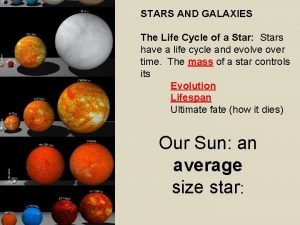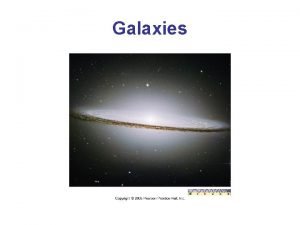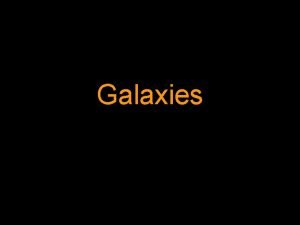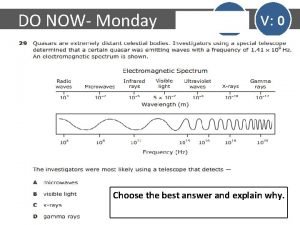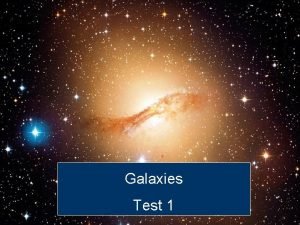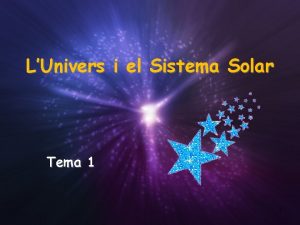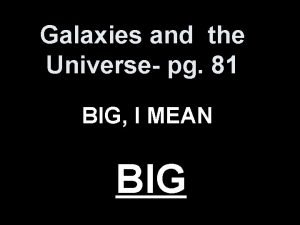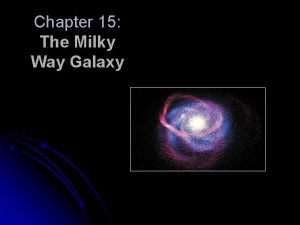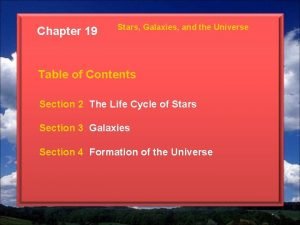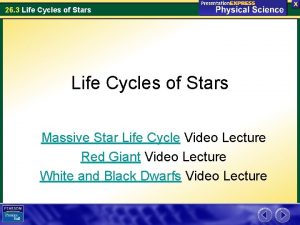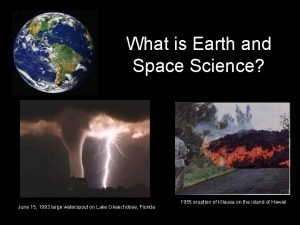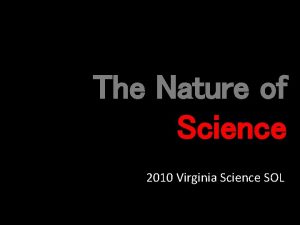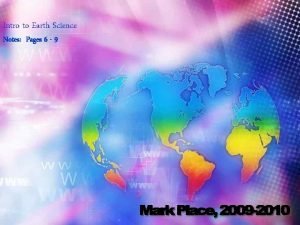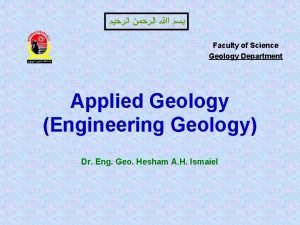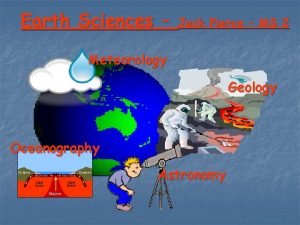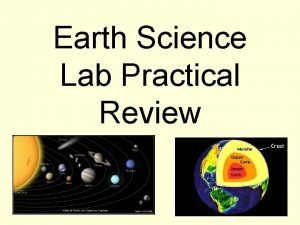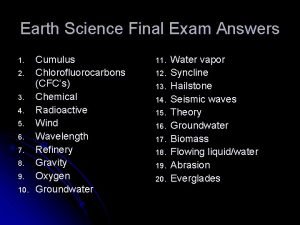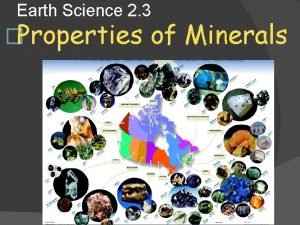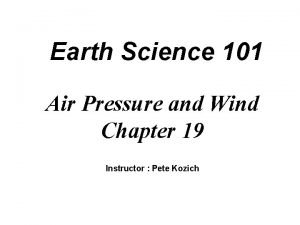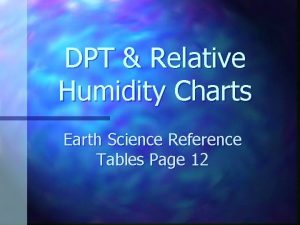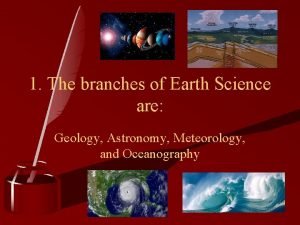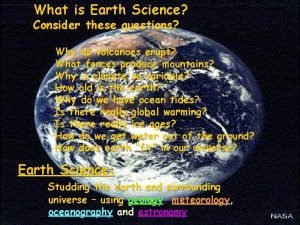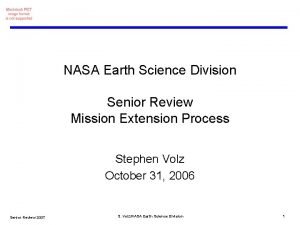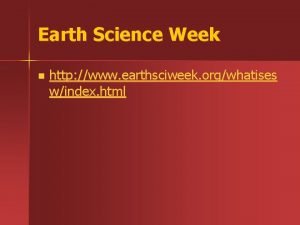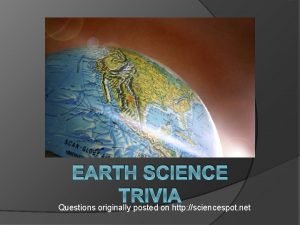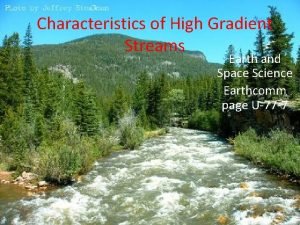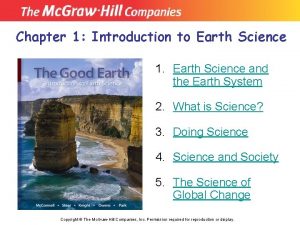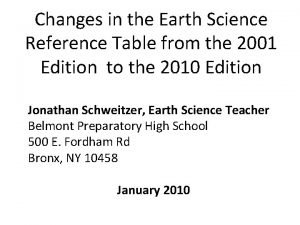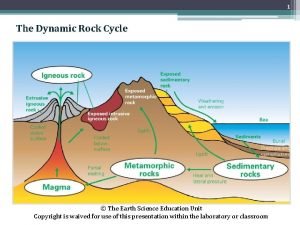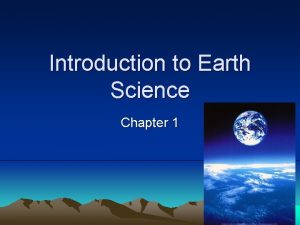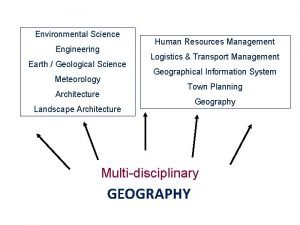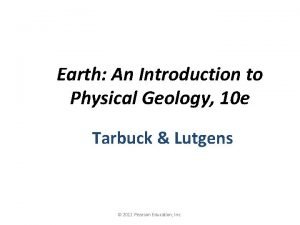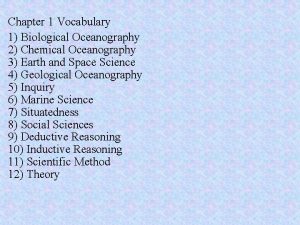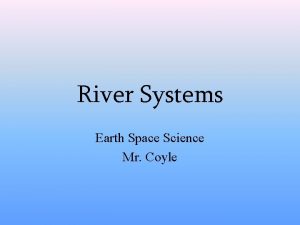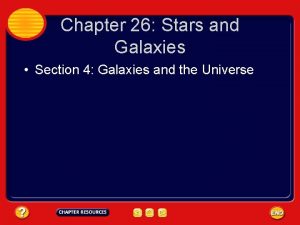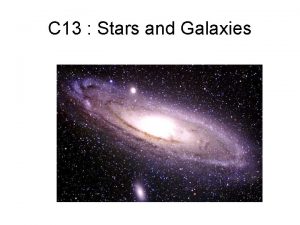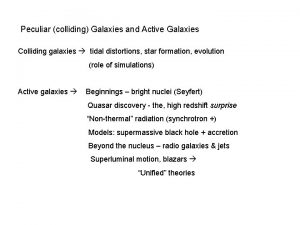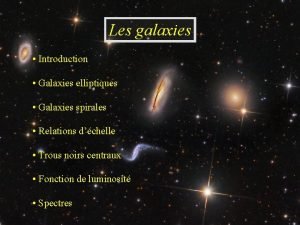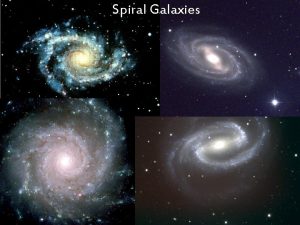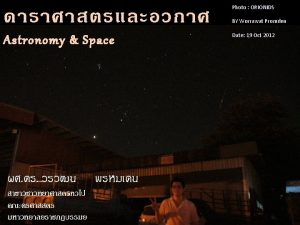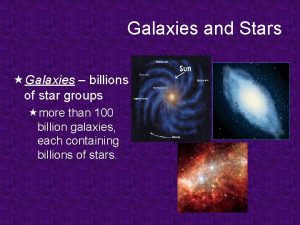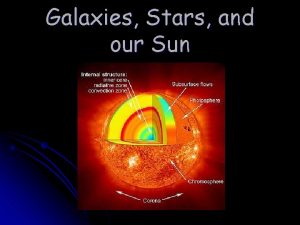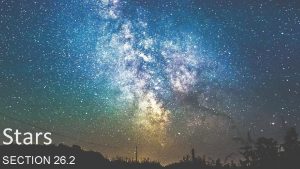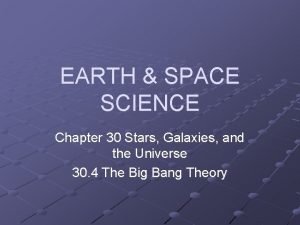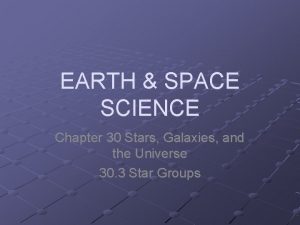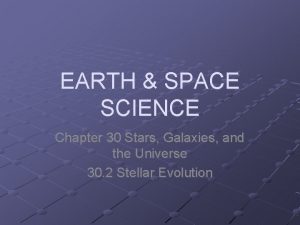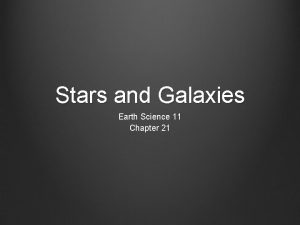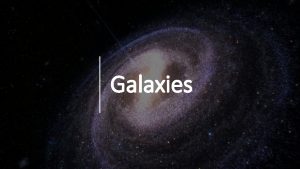Ch 25 Stars and Galaxies Earth Science Section






































































- Slides: 70

Ch. 25 Stars and Galaxies Earth Science

Section 1 – Stars � Learning Objectives • Explain why some constellations are visible only during certain seasons. • Distinguish between absolute magnitude and apparent magnitude.

Section 1 – Stars � A. Patterns of stars – constellations • 1. Ancient cultures used mythology or everyday items to name constellations • 2. Modern astronomy studies 88 constellations

• 3. Some constellations are not visible all year because Earth revolves around the Sun. • 4. Circumpolar constellations in the northern sky appear to circle around Polaris and are visible all year.

� B. Star magnitude • 1. Absolute magnitude – measure of the amount of light a star actually gives off • 2. Apparent magnitude – measure of the amount of a star’s light received on Earth


� C. Space measurement • 1. Astronomers measure a star’s parallax – shift in its position when viewed from two different angles. Demonstrate parallax shift by holding your hand out in front of you with your thumb sticking up (each of your eyes are in 2 different positions) Close one eye and then switch.


• 2. Distance is measured in light-years – the distance light travels in a year. • Extra cool facts: �Light travels 186, 000 miles/sec or ~ 300, 000 meters/sec �Diameter of Earth = 7, 926 miles…so, light can travel about the distance of 23 Earth’s in 1 second

Parsecs is a unit to measure distance, not time. 1 parsec = 3. 26 light years



� D. Star properties • 1. Color indicates temperature • �a. Hot stars are blue-white �b. Cool stars look orange or red �c. Yellow stars like the Sun are medium temperature

• 2. A spectroscope breaks the visible light from a star into a spectrum. �a. Spectrum indicates elements in the star’s atmosphere



Discussion Question � Why are circumpolar constellations always visible?

Discussion Question � Why are circumpolar constellations always visible? • Because of their unique position, these stars are visible in the northern sky each season • Other constellations, such as Orion – visible in the winter months – are not always visible

Section 2 – The Sun � Learning Objectives • Explain that the Sun is the closest star to Earth. • Describe the structure of the Sun. • Describe sunspots, prominences, and solar flares.

Section 2 – The Sun � A. Sun’s layers – energy created in the core moves outward through the radiation zone and the convection zone and into the Sun’s atmosphere.

� B. Sun’s atmosphere • 1. Photosphere – lowest layer gives off light and is about 6, 000 K (Kelvin) (10, 340°F)

• 2. Chromosphere is the next layer about 2, 000 km above the photosphere

• 3. Extending millions of km into space, the 2 million K corona releases charge particles (photons) as solar wind.

� C. Surface features • 1. Sunspots – dark areas cooler than their surroundings

�a. Temporary features which come and go over days, weeks, or months �b. Increase and decrease in a 10 to 11 year pattern called solar activity cycle

• 2. Sunspots are related to intense magnetic fields �a. Magnetic fields may cause prominences – huge, arching gas columns �b. Violent eruptions near a sunspot are called solar flares

Sun prominence


http: //ircamera. as. arizona. edu/Nat. Sci 102/lectures/sun. htm National Science Website

• 3. Bright coronal mass ejections (CMEs) appear as a halo around the Sun when emitted in the Earth’s direction �a. Highly charged solar wind particles can disrupt radio signals.

�b. Near Earth’s polar areas solar wind material can create light called an aurora (interacts with the ionosphere in our atmosphere)

� D. Sun is mostly average • 1. Middle-aged star • 2. Typical absolute magnitude with yellow light • 3. Unusual – Sun is not part of a multiple star system or cluster Star cluster

Discussion Question � How is the Sun similar to and different from other stars?

Discussion Question � How is the Sun similar to and different from other stars? • Similar – typical age, absolute magnitude (brightness) and color • Different – NOT part of a star system or cluster

Section 3 – Evolution of Stars � Learning Objectives • Describe how stars are classified • Compare the Sun to other types of stars on the H-R diagram. • Describe how stars evolve.

Section 3 – Evolution of Stars � A. Classifying stars – Ejnar Hertzsprung and Henry Russell graphed stars by temperature and absolute magnitude in a H-R diagram

• 1. Main Sequence – diagonal band on H-R diagram �a. Upper left – hot, blue, bright stars �b. Lower right – cool, red, dim stars �c. Middle – average yellow stars like the Sun • 2. Dwarfs and giants – the 10% of stars that don’t fall in the main sequence


� B. Fusion of hydrogen (H) occurs in star cores releasing huge amounts of energy

� C. Evolution of stars • 1. A nebula contracts and breaks apart from the instability caused by gravity �a. Temperatures in each nebula chunk increase as particles move closer together �b. At 10 million K fusion begins and energy from a new star radiates into space Image from Hubble space telescope


• 2. The new main sequence star balances pressure from fusion heat with gravity �a. Balance is lost when core of hydrogen (H) fuel is used up �b. Core contracts and heats up causing outer layers to expand cool �c. Star becomes a giant as it expands and outer layers cool �d. Helium (He) nuclei fuse to form core of carbon (C) Small star

• 3. A white dwarf forms from the giant star �a. Helium (He) is exhausted and outer layers escape into space �b. Core contracts into hot, dense, small star Small star


• 4. In massive stars fusion causes higher temperatures and greater expansion into a supergiant �a. Eventually fusion stops as iron (Fe) is formed �b. The core crashes inward causing the outer part to explode as an incredibly bright supernova

• 5. The collapsed core of a supernova may form a neutron star of extremely high density

• 6. The mass of a tremendously big supernova core can collapse to a point, forming a black hole. �a. Gravity is so strong not even light can escape �b. Beyond a black hole’s event horizon gravity operates as it would before the mass collapsed.


• 7. Matter emitted by a star over its life time is recycled and can become part of a new nebula Leftover matter from a supernova which can form a new nebula Hubble space telescope

Discussion Question � If the Sun is too young to have formed carbon and iron on its own, how did these elements get into the Sun?

Discussion Question � If the Sun is too young to have formed carbon and iron on its own, how did these elements get into the Sun? • These elements are part of old, dead stars that have been recycled into the Sun

Section 4 – Galaxies and the Universe � Learning Objectives • Describe the Sun’s position in the Milky Way Galaxy. • Explain that the same natural laws that apply to our solar system also apply to other galaxies.

Section 4 – Galaxies and the Universe � A. Galaxy – gravity holds together a large collection of stars, gas, and dust • 1. Earth’s galaxy is Milky Way which is part of a galaxy cluster named the Local Group.


• 2. Spiral galaxies – spiral arms wind out from inner section; some have barred spirals with stars and gas in a central bar. Infrared – Spiral Galaxy, NASA image

• 3. Elliptical galaxies – large, three-dimensional ellipses; most common shape NASA images

• 4. Irregular galaxies – smaller, less common galaxies with various different shapes NASA image

� B. The Milky Way Galaxy – usually classified as a spiral galaxy • 1. May contain one trillion stars • 2. About 100, 000 light years wide. • 3. Sun orbits galaxy’s core every 225 million years Predicted image of our galaxy

� C. Theories on the origin of the universe • 1. Steady state theory – universe has always existed just as it is now • The Steady State theory fails, however, in one important way. If matter is continuously created everywhere, then the average of stars in any section of the universe should be the same. But astronomers have found that not to be true. (No longer widely supported)

• 2. Oscillating model – universe expands and contracts repeatedly over time With enough mass, the universe will eventually succumb to the overpowering force of gravity and collapse again into a single point—a theory often called the Big Crunch. (No longer widely supported) But without enough mass, the universe will continue to expand. As of 2001, many scientists concluded this appears to be most likely; that the universe will continue to expand.

� D. Universe is expanding • 1. Doppler Shift – light changes as it moves toward or away from an object �a. Starlight moving toward Earth shifts to blue-violet end of spectrum �b. Starlight moving away from Earth shifts to red end of spectrum


• 2. All galaxies outside the Local Group indicate a red shift in their spectra indicating they are moving away from Earth.

� E. Big Bang Theory – holds that universe began 13. 7 billion years ago with huge explosion that caused expansion everywhere at the same time. (Currently widely supported)

� In 1965 two scientists made a discovery that solidified the Big Bang theory. Arno Penzias and Robert Wilson of Bell Telephone Laboratories detected faint microwave radiation that came from all points of the sky. � They and other physicists theorized that they were seeing the afterglow from the Big Bang's explosion. Since the Big Bang affected the entire universe at the same moment in time, the afterglow should be seen in the entire universe and could be detected no matter what direction you looked.

This afterglow is called the cosmic background radiation. Its wavelength and uniformity fit nicely with other astronomers' mathematical calculations about the Big Bang.

� In 1998, astronomers found an even more remarkable puzzle: the universe seems to be accelerating while expanding, as if being pulled by some kind of "antigravity" force. � Other astronomers have since confirmed this finding using a variety of methods, and are still investigating the existence of this mysterious "dark energy. "

• 1. Galaxies more than 10 billion light-years away give information about a young universe • 2. Whether the universe may eventually stop expanding and begin contracting is unknown

Discussion Question � What is common among all galaxies? Hubble image of galaxies

Discussion Question � What is common among all galaxies? • They are expanding
 Waves are produced by stars and galaxies
Waves are produced by stars and galaxies There are millions of stars in the sky
There are millions of stars in the sky Chapter 30 galaxies and the universe
Chapter 30 galaxies and the universe Galaxys
Galaxys Life cycle of galaxies
Life cycle of galaxies Facts about elliptical galaxies
Facts about elliptical galaxies Classification
Classification The pity relation for an adiabatic expansion is
The pity relation for an adiabatic expansion is Most galaxies in the inner region of a large cluster are
Most galaxies in the inner region of a large cluster are Types of galaxies
Types of galaxies Brainpop galaxies quiz answers
Brainpop galaxies quiz answers 4 types of galaxies
4 types of galaxies How are galaxies classified? *
How are galaxies classified? * Tipus de galaxies
Tipus de galaxies Type of galaxy
Type of galaxy Evolution of galaxies
Evolution of galaxies Billions of galaxies
Billions of galaxies Galaxies lesson plan
Galaxies lesson plan Her favorite subject is math
Her favorite subject is math Chapter 19 section 2 the life cycle of stars answer key
Chapter 19 section 2 the life cycle of stars answer key Section 26.3 life cycles of stars
Section 26.3 life cycles of stars Earth science lab practical
Earth science lab practical Earthology definition
Earthology definition A pattern of meteorological symbols that represent weather
A pattern of meteorological symbols that represent weather Earth science sol 2010
Earth science sol 2010 Earth science lab practical
Earth science lab practical Earth science regents lab practical
Earth science regents lab practical Earth science grade 9
Earth science grade 9 Dynamic equilibrium earth science
Dynamic equilibrium earth science Which is part of the hydrosphere?
Which is part of the hydrosphere? 4th grade science jeopardy
4th grade science jeopardy Geology earth science definition
Geology earth science definition Dinoflagellates
Dinoflagellates Earth science meaning
Earth science meaning Geology earth science definition
Geology earth science definition Earth science sol review
Earth science sol review Earth science vs geology
Earth science vs geology Earth science final
Earth science final Earth science lab practical
Earth science lab practical Earth science semester 2 final exam answers
Earth science semester 2 final exam answers Define streak in earth science
Define streak in earth science Mercury barometer
Mercury barometer Relative humidity reference table
Relative humidity reference table What are the three major branches of earth science
What are the three major branches of earth science 282 ways to pass the earth science regents
282 ways to pass the earth science regents Earth science vs geology
Earth science vs geology Honors earth science
Honors earth science Why study earth science
Why study earth science Traditions in geography
Traditions in geography Plate earth science
Plate earth science The sun warms the earth unevenly science or pseudoscience
The sun warms the earth unevenly science or pseudoscience Earth science review book
Earth science review book Nasa divisions
Nasa divisions Earth science week
Earth science week Earth science trivia questions
Earth science trivia questions Earth science prologue review
Earth science prologue review Earth science jeopardy
Earth science jeopardy Earth system science graphic organizer
Earth system science graphic organizer High gradient streams
High gradient streams Chapter 1 introduction to earth science
Chapter 1 introduction to earth science Earth science reference table page 16
Earth science reference table page 16 Earth science
Earth science Earth science
Earth science Whats an isoline map
Whats an isoline map Earth science introduction
Earth science introduction Earth science
Earth science Earth science
Earth science Earth science chapter 1 vocabulary
Earth science chapter 1 vocabulary What is deposition? *
What is deposition? * Earth science jeopardy
Earth science jeopardy Cut bank earth science
Cut bank earth science




